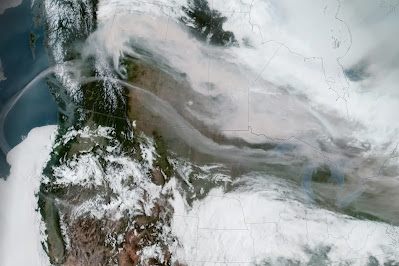 |
| The late, great Tonks in her St. Albans, Vermont yard on a breezy winter day in 2017, enjoying the scents in the air. |
Tonks was a gracious, zen-like presence who taught us all to savor the simple things in life, like a comfortable bed and the smells and sounds of nature outdoors. And meal time. Don't forget that.
She was the beneficiary of great genes, making her a stunningly beautiful pup. She was a Golden Retriever and Cocker Spaniel mix. That gave her luscious blonde hair, soulful eyes, fun floppy ears and a cute button nose.
Tonks came into our lives when she was seven years old. In the first chapter of her life, she lived with a Vermont couple, who eventually formed a family that included two very active, very young children. The couple knew the kids were probably too much for Tonk's gentle, calm nature.
The family generously and selflessly let us adopt Tonks, who quickly settled into a new life with goofy brother Jackson and her new parents Jeff and Matt.
 |
| Tonks in the foreground enjoys a laugh while her brother Jackson in the background not getting the joke on a sunny autumn day in 2015. |
She also enjoyed laying down on the deck and watching the cars on the road zip by, and the birds flutter around overhead.
Tonks was no loner, though. She loved visiting people when they stopped by, accepting with pleasure a little neck scratch and just the companionship she enjoyed when human friends were around.
Every day, breakfast and dinner were cause for big celebration. After these daily feasts, she'd settle down in the soft bed she loved for comfortable naps.
Another particular joy for Tonks came in the summer, when it was time for dad Matt to thin the carrot crop in the raised beds. She and brother Jackson would safely dispose of the delicious mini-carrots Matt would dig up by immediately chowing them down. The carrots were her favorite food.
 |
| Tonks enjoying a rest on her comfortable bed, 2019. |
She especially loved weather watching with Matt on sunny, windy days. However, Tonks was not a particular fan of snow, especially if it was deep.
Tonks, always the helpful pup, was our early warning system for any truck deliveries that appeared in our driveway. She'd hear the beep-beep-beep of the truck backing up, and start barking loudly to announce the delivery arrival.
She was also a bit of a prankster. As her dad Jeff settled into his easy chair to watch TV in the evenings, Tonks would quietly slip into the hallway behind him. After awhile, she'd let out a single loud bark, propelling Jeff to the ceiling.
In Tonks' later years, her hearing diminished and her hind legs grew weak and unstable. But she never gave up her curiosity, and that zen-like life of smelling the aromas in the air continued until the end.
 |
| Tonks, left, and her brother Jackson, help dad Matt with his weather blog by sniffing the air for clues as to when the snow would stop during a large 2018 winter storm |
She was predeceased by her loving grandparents Don and Lois Modereger of Yankton, South Dakota and Henry and Pauline Sutkoski of West Rutland, Vermont.
In lieu of flowers, Tonks asked that you make a contribution or volunteer at your local Humane Society. She also said that if you want to add another doggo to your family, please consider adoption.
Tonks passed away in late spring, probably the most fragrant time of year for many of us. She asks that you go outside, sit down facing the wind, close your eyes and breathe in the wonderful aromas of nature.
It was Tonks' way of doing things and being happy, and this works for humans, too.


























